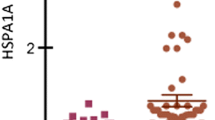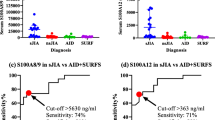Abstract
Heat shock protein (Hsp) 60 has been implicated in the pathogenesis of various inflammatory and autoimmune diseases. This study aimed to investigate synovial fluid and serum concentrations of Hsp60 and anti-Hsp60 and their relationship with juvenile idiopathic arthritis (JIA). Forty-eight patients with JIA, including 22 oligo-articular, 19 poly-articular, and 7 systemic diseases, and 33 normal controls were enrolled in this study. Synovial fluid and serum Hsp60 and anti-Hsp60 concentrations were measured via ELISA. Serum concentrations of Hsp60 of active and inactive oligo- and poly-articular JIA were significantly higher than those of normal controls. Serum concentration of anti-Hsp60 in active oligo-articular JIA was higher than that of normal controls (49.25 vs. 35.76 ng/mL, p = 0.059). Similarly, serum concentration of anti-Hsp60 in active poly-articular JIA was significantly higher than that of inactive samples (65.05 vs. 26.54 ng/mL, p = 0.008). In addition, serum concentration of Hsp60 correlated with the time required for remission from flare-ups in patients with JIA. Serum concentration of Hsp60 correlated well with time required for remission from flare-ups in patients with JIA, representing a potential disease marker to monitor disease activity.



Similar content being viewed by others
Abbreviations
- Hsp:
-
Heat shock protein
- JIA:
-
Juvenile idiopathic arthritis
- Treg:
-
Regulatory T cells
- TLR:
-
Toll-like receptor
- CD:
-
Cluster of differentiation
- APC:
-
Antigen-presenting cells
- MyD88:
-
Myeloid differentiation factor 88
- TIR:
-
Toll/interleukin-1 receptor
- TIRAP:
-
TIR domain-containing adaptor
- TRIF:
-
TIR domain-containing adapter-inducing interferon-β
- PBMC:
-
Peripheral blood-derived mononuclear cells
- IL:
-
Interleukin
- IFN:
-
Interferon
References
Hartl FU, Hayer-Hartl M (2002) Molecular chaperones in the cytosol: from nascent chain to folded protein. Science (New York, NY) 295(5561):1852–1858
Bukau B, Weissman J, Horwich A (2006) Molecular chaperones and protein quality control. Cell 125(3):443–451
Beg AA (2002) Endogenous ligands of Toll-like receptors: implications for regulating inflammatory and immune responses. Trends Immunol 23(11):509–512
Srivastava P (2002) Roles of heat-shock proteins in innate and adaptive immunity. Nat rev 2(3):185–194
Zanin-Zhorov A, Bruck R, Tal G, Oren S, Aeed H, Hershkoviz R, Cohen IR, Lider O (2005) Heat shock protein 60 inhibits th1-mediated hepatitis model via innate regulation of th1/th2 transcription factors and cytokines. J Immunol 174(6):3227–3236
Zanin-Zhorov A, Cahalon L, Tal G, Margalit R, Lider O, Cohen IR (2006) Heat shock protein 60 enhances CD4+ CD25+ regulatory t cell function via innate tlr2 signaling. J Clin Investig 116(7):2022–2032
Zanin-Zhorov A, Nussbaum G, Franitza S, Cohen IR, Lider O (2003) T cells respond to heat shock protein 60 via tlr2: activation of adhesion and inhibition of chemokine receptors. FASEB J 17(11):1567–1569
Cohen-Sfady M, Nussbaum G, Pevsner-Fischer M, Mor F, Carmi P, Zanin-Zhorov A, Lider O, Cohen IR (2005) Heat shock protein 60 activates B cells via the tlr4-myd88 pathway. J Immunol 175(6):3594–3602
Arnold-Schild D, Hanau D, Spehner D, Schmid C, Rammensee HG, de la Salle H, Schild H (1999) Cutting edge: receptor-mediated endocytosis of heat shock proteins by professional antigen-presenting cells. J Immunol 162(7):3757–3760
Theriault JR, Mambula SS, Sawamura T, Stevenson MA, Calderwood SK (2005) Extracellular Hsp70 binding to surface receptors present on antigen presenting cells and endothelial/epithelial cells. FEBS Lett 579(9):1951–1960
Basu S, Binder RJ, Ramalingam T, Srivastava PK (2001) Cd91 is a common receptor for heat shock proteins gp96, Hsp90, Hsp70, and calreticulin. Immunity 14(3):303–313
Wang Y, Kelly CG, Karttunen JT, Whittall T, Lehner PJ, Duncan L, MacAry P, Younson JS, Singh M, Oehlmann W, Cheng G, Bergmeier L, Lehner T (2001) CD40 is a cellular receptor mediating mycobacterial heat shock protein 70 stimulation of CC-chemokines. Immunity 15(6):971–983
Floto RA, MacAry PA, Boname JM, Mien TS, Kampmann B, Hair JR, Huey OS, Houben EN, Pieters J, Day C, Oehlmann W, Singh M, Smith KG, Lehner PJ (2006) Dendritic cell stimulation by mycobacterial Hsp70 is mediated through CCR5. Science (New York, NY) 314(5798):454–458
Perschinka H, Wellenzohn B, Parson W, van der Zee R, Willeit J, Kiechl S, Wick G (2007) Identification of atherosclerosis-associated conformational heat shock protein 60 epitopes by phage display and structural alignment. Atherosclerosis 194(1):79–87
Xiao Q, Mandal K, Schett G, Mayr M, Wick G, Oberhollenzer F, Willeit J, Kiechl S, Xu Q (2005) Association of serum-soluble heat shock protein 60 with carotid atherosclerosis: clinical significance determined in a follow-up study. Stroke: A Journal of Cerebral Circulation 36(12):2571–2576
Gaston JS, Life PF, Bailey LC, Bacon PA (1989) In vitro responses to a 65-kilodalton mycobacterial protein by synovial T cells from inflammatory arthritis patients. J Immunol 143(8):2494–2500
van Eden W, Thole JE, van der Zee R, Noordzij A, van Embden JD, Hensen EJ, Cohen IR (1988) Cloning of the mycobacterial epitope recognized by T lymphocytes in adjuvant arthritis. Nature 331(6152):171–173
Conroy SE, Tucker L, Latchman DS, Isenberg DA (1996) Incidence of anti Hsp90 and 70 antibodies in children with SLE, juvenile dermatomyositis and juvenile chronic arthritis. Clin Exp Rheumatol 14(1):99–104
Elst EF, Klein M, de Jager W, Kamphuis S, Wedderburn LR, van der Zee R, Albani S, Kuis W, Prakken BJ (2008) Hsp60 in inflamed muscle tissue is the target of regulatory autoreactive T cells in patients with juvenile dermatomyositis. Arthritis Rheum 58(2):547–555
Laad AD, Thomas ML, Fakih AR, Chiplunkar SV (1999) Human gamma delta T cells recognize heat shock protein-60 on oral tumor cells. Int J Cancer 80(5):709–714
Thomas ML, Samant UC, Deshpande RK, Chiplunkar SV (2000) Gammadelta T cells lyse autologous and allogenic oesophageal tumours: involvement of heat-shock proteins in the tumour cell lysis. Cancer Immunol Immunother 48(11):653–659
Anthony LS, Wu H, Sweet H, Turnnir C, Boux LJ, Mizzen LA (1999) Priming of CD8+ ctl effector cells in mice by immunization with a stress protein-influenza virus nucleoprotein fusion molecule. Vaccine 17(4):373–383
Blachere NE, Li Z, Chandawarkar RY, Suto R, Jaikaria NS, Basu S, Udono H, Srivastava PK (1997) Heat shock protein–peptide complexes, reconstituted in vitro, elicit peptide-specific cytotoxic T lymphocyte response and tumor immunity. J Exp Med 186(8):1315–1322
Gao B, Tsan MF (2003) Recombinant human heat shock protein 60 does not induce the release of tumor necrosis factor alpha from murine macrophages. J Biol Chem 278(25):22523–22529
Gao B, Tsan MF (2003) Endotoxin contamination in recombinant human heat shock protein 70 (Hsp70) preparation is responsible for the induction of tumor necrosis factor alpha release by murine macrophages. J Biol Chem 278(1):174–179
Osterloh A, Meier-Stiegen F, Veit A, Fleischer B, von Bonin A, Breloer M (2004) Lipopolysaccharide-free heat shock protein 60 activates T cells. J Biol Chem 279(46):47906–47911
Panjwani NN, Popova L, Srivastava PK (2002) Heat shock proteins gp96 and Hsp70 activate the release of nitric oxide by APCS. J Immunol 168(6):2997–3003
van den Broek MF, Hogervorst EJ, Van Bruggen MC, Van Eden W, van der Zee R, van den Berg WB (1989) Protection against streptococcal cell wall-induced arthritis by pretreatment with the 65-kD mycobacterial heat shock protein. J Exp Med 170(2):449–466
Thompson SJ, Francis JN, Siew LK, Webb GR, Jenner PJ, Colston MJ, Elson CJ (1998) An immunodominant epitope from mycobacterial 65-kDa heat shock protein protects against pristane-induced arthritis. J Immunol 160(9):4628–4634
Kingston AE, Hicks CA, Colston MJ, Billingham ME (1996) A 71-kD heat shock protein (Hsp) from mycobacterium tuberculosis has modulatory effects on experimental rat arthritis. Clin Exp Immunol 103(1):77–82
Huang JL, Kuo ML, Hung IJ, Wu CJ, Ou LH, Cheng JH (2001) Lowered IL-4-producing t cells and decreased IL-4 secretion in peripheral blood from subjects with juvenile rheumatoid arthritis. Chang Gung Med J 24(2):77–83
Nguyen TT, Zlacka D, Vavrincova P, Sedlacek P, Hromadnikova I (2006) Detection of antibodies against 60-, 65- and 70-kDa heat shock proteins in paediatric patients with various disorders using Western blotting and elisa. Clin Chem Lab Med 44(4):442–449
Zlacka D, Vavrincova P, Hien Nguyen TT, Hromadnikova I (2006) Frequency of anti-Hsp60, -65 and -70 antibodies in sera of patients with juvenile idiopathic arthritis. J Autoimmun 27(2):81–88
Petty RE, Southwood TR, Baum J, Bhettay E, Glass DN, Manners P, Maldonado-Cocco J, Suarez-Almazor M, Orozco-Alcala J, Prieur AM (1998) Revision of the proposed classification criteria for juvenile idiopathic arthritis: Durban, 1997. J Rheumatol 25(10):1991–1994
Pinals RS, Masi AT, Larsen RA (1981) Preliminary criteria for clinical remission in rheumatoid arthritis. Arthritis Rheum 24(10):1308–1315
Kumaraguru U, Pack CD, Rouse BT (2003) Toll-like receptor ligand links innate and adaptive immune responses by the production of heat-shock proteins. J Leukoc Biol 73(5):574–583
Bulut Y, Michelsen KS, Hayrapetian L, Naiki Y, Spallek R, Singh M, Arditi M (2005) Mycobacterium tuberculosis heat shock proteins use diverse Toll-like receptor pathways to activate pro-inflammatory signals. J Biol Chem 280(22):20961–20967
Quintana FJ, Carmi P, Mor F, Cohen IR (2002) Inhibition of adjuvant arthritis by a DNA vaccine encoding human heat shock protein 60. J Immunol 169(6):3422–3428
de Kleer IM, Kamphuis SM, Rijkers GT, Scholtens L, Gordon G, De Jager W, Hafner R, van de Zee R, van Eden W, Kuis W, Prakken BJ (2003) The spontaneous remission of juvenile idiopathic arthritis is characterized by CD30+ T cells directed to human heat-shock protein 60 capable of producing the regulatory cytokine interleukin-10. Arthritis Rheum 48(7):2001–2010
Kamphuis S, Kuis W, de Jager W, Teklenburg G, Massa M, Gordon G, Boerhof M, Rijkers GT, Uiterwaal CS, Otten HG, Sette A, Albani S, Prakken BJ (2005) Tolerogenic immune responses to novel T-cell epitopes from heat-shock protein 60 in juvenile idiopathic arthritis. Lancet 366(9479):50–56
Prakken BJ, Roord S, van Kooten PJ, Wagenaar JP, van Eden W, Albani S, Wauben MH (2002) Inhibition of adjuvant-induced arthritis by interleukin-10-driven regulatory cells induced via nasal administration of a peptide analog of an arthritis-related heat-shock protein 60 T cell epitope. Arthritis Rheum 46(7):1937–1946
Nguyen TT, Gehrmann M, Zlacka D, Sosna A, Vavrincova P, Multhoff G, Hromadnikova I (2006) Heat shock protein 70 membrane expression on fibroblast-like synovial cells derived from synovial tissue of patients with rheumatoid and juvenile idiopathic arthritis. Scand J Rheumatol 35(6):447–453
Yokota S, Minota S, Fujii N (2006) Anti-Hsp auto-antibodies enhance Hsp-induced pro-inflammatory cytokine production in human monocytic cells via Toll-like receptors. Int Immunol 18(4):573–580
Acknowledgments
This work was supported by grants from the National Science Council, Taiwan (grant no. NSC95-2314-B-182A-172-MY3, to JH).
Competing interests
The author(s) declare that they have no competing interests.
Author information
Authors and Affiliations
Corresponding author
Additional information
Wu and Ou contributed equally to this paper.
Rights and permissions
About this article
Cite this article
Wu, CT.C., Ou, LS., Yeh, KW. et al. Serum heat shock protein 60 can predict remission of flare-up in juvenile idiopathic arthritis. Clin Rheumatol 30, 959–965 (2011). https://doi.org/10.1007/s10067-011-1709-2
Received:
Revised:
Accepted:
Published:
Issue Date:
DOI: https://doi.org/10.1007/s10067-011-1709-2




